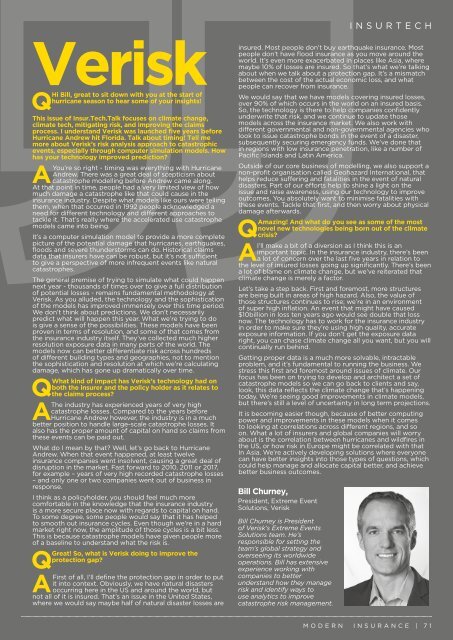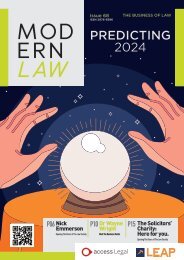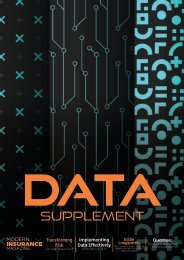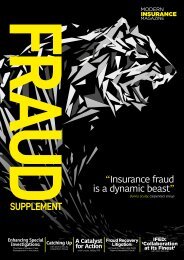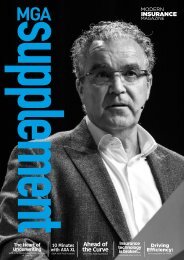Modern Insurance Magazine Issue 60
This issue features... Insight: Every Cloud Has A Silver Lining, by Tim Yeates, Co-Founder, Carbon1 Ltd. Interview: Modelling Modern Risk with Dr Kirsten Mitchell-Wallace, Director of Portfolio Risk Management, Lloyd’s of London Interview: Searching for Answers with Iain Willis, Research Director, Gallagher Research Centre Editorial Board: Find out what our editorial board panel of experts have to say in this edition of Modern Insurance Magazine A Final Word with Steve White, Chief Executive, British Insurance Brokers' Association (BIBA) Is it time for Risk Managers to rethink their role in the Climate Crisis? by François Lanavère, Head of Strategic Partnerships, AXA Climate Associations Assemble: Modern Insurance’s panel of resident associations outline the burning issues in insurance Just a Thought with Eddie Longworth - Building Trust through Responsible AI in Claims: Championing a Voluntary Code of Conduct Making Efficiency Gains in Subsidence Claims, by Chris Carlton MRICS, New Business & Key Account Director, Geobear Chemistry for a Sustainable Future: Q&A with Grant Dempsey, Sales Manager - Distribution, BASF Automotive Refinish UK & Ireland Industry Collaboration: Working together to provide the best mobility solution, with James Roberts, Business Development Director, Insurance, Europcar Mobility Group UK Thinking Upside Down: Mind the Protection Gap, by Ashley Preece, Product Owner, Claim Technology In Conversation with… Neil Garrett, UK, South Africa & Nordics Sales Director, Solera | Audatex A New Climate for Claims, from I Love Claims / ARC 360 10 Mins with… Ola Jacob, Independent Insurance Advisor In Celebration: Modern Claims Awards 2023 Insur.Tech.Talk - Interviews with Stephen Weinstein, Former Chair of the Bermuda Business Development Agency; Bill Churney, President, Extreme Event Solutions, Verisk; Jacqui LeGrand, CEO, Maptycs; Heather H. Wilson, Chief Executive Officer, CLARA Analytics Insur.Tech.Talk Editorial Board - Experts from within the insurtech sector and beyond join us once more to share their unique insights!
This issue features...
Insight: Every Cloud Has A Silver Lining, by Tim Yeates, Co-Founder, Carbon1 Ltd.
Interview: Modelling Modern Risk with Dr Kirsten Mitchell-Wallace, Director of Portfolio Risk Management, Lloyd’s of London
Interview: Searching for Answers with Iain Willis, Research Director, Gallagher Research Centre
Editorial Board: Find out what our editorial board panel of experts have to say in this edition of Modern Insurance Magazine
A Final Word with Steve White, Chief Executive, British Insurance Brokers' Association (BIBA)
Is it time for Risk Managers to rethink their role in the Climate Crisis? by François Lanavère, Head of Strategic Partnerships, AXA Climate
Associations Assemble: Modern Insurance’s panel of resident associations outline the burning issues in insurance
Just a Thought with Eddie Longworth - Building Trust through Responsible AI in Claims: Championing a Voluntary Code of Conduct
Making Efficiency Gains in Subsidence Claims, by Chris Carlton MRICS, New Business & Key Account Director, Geobear
Chemistry for a Sustainable Future: Q&A with Grant Dempsey, Sales Manager - Distribution, BASF Automotive Refinish UK & Ireland
Industry Collaboration: Working together to provide the best mobility solution, with James Roberts, Business Development Director, Insurance, Europcar Mobility Group UK
Thinking Upside Down: Mind the Protection Gap, by Ashley Preece, Product Owner, Claim Technology
In Conversation with… Neil Garrett, UK, South Africa & Nordics Sales Director, Solera | Audatex
A New Climate for Claims, from I Love Claims / ARC 360
10 Mins with… Ola Jacob, Independent Insurance Advisor
In Celebration: Modern Claims Awards 2023
Insur.Tech.Talk - Interviews with Stephen Weinstein, Former Chair of the Bermuda Business Development Agency; Bill Churney, President, Extreme Event Solutions, Verisk; Jacqui LeGrand, CEO, Maptycs; Heather H. Wilson, Chief Executive Officer, CLARA Analytics
Insur.Tech.Talk Editorial Board - Experts from within the insurtech sector and beyond join us once more to share their unique insights!
Create successful ePaper yourself
Turn your PDF publications into a flip-book with our unique Google optimized e-Paper software.
Verisk<br />
insured.<br />
Hi Bill, great to sit down with you at the start of<br />
hurricane season to hear some of your insights!<br />
Q<br />
This issue of Insur.Tech.Talk focuses on climate change,<br />
climate tech, mitigating risk, and improving the claims<br />
process. I understand Verisk was launched five years before<br />
Hurricane Andrew hit Florida. Talk about timing! Tell me<br />
more about Verisk’s risk analysis approach to catastrophic<br />
events, especially through computer simulation models. How<br />
has your technology improved prediction?<br />
AYou’re so right - timing was everything with Hurricane<br />
Andrew. There was a great deal of scepticism about<br />
catastrophe modelling before Andrew came along.<br />
At that point in time, people had a very limited view of how<br />
much damage a catastrophe like that could cause in the<br />
insurance industry. Despite what models like ours were telling<br />
them, when that occurred in 1992 people acknowledged a<br />
need for different technology and different approaches to<br />
tackle it. That’s really where the accelerated use catastrophe<br />
models came into being.<br />
It’s a computer simulation model to provide a more complete<br />
picture of the potential damage that hurricanes, earthquakes,<br />
floods and severe thunderstorms can do. Historical claims<br />
data that insurers have can be robust, but it’s not sufficient<br />
to give a perspective of more infrequent events like natural<br />
catastrophes.<br />
The general premise of trying to simulate what could happen<br />
next year - thousands of times over to give a full distribution<br />
of potential losses - remains fundamental methodology at<br />
Verisk. As you alluded, the technology and the sophistication<br />
of the models has improved immensely over this time period.<br />
We don’t think about predictions. We don’t necessarily<br />
predict what will happen this year. What we’re trying to do<br />
is give a sense of the possibilities. These models have been<br />
proven in terms of resolution, and some of that comes from<br />
the insurance industry itself. They’ve collected much higher<br />
resolution exposure data in many parts of the world. The<br />
models now can better differentiate risk across hundreds<br />
of different building types and geographies, not to mention<br />
the sophistication and resolution at which we’re calculating<br />
damage, which has gone up dramatically over time.<br />
Q<br />
A<br />
What kind of impact has Verisk’s technology had on<br />
both the insurer and the policy holder as it relates to<br />
the claims process?<br />
The industry has experienced years of very high<br />
catastrophe losses. Compared to the years before<br />
Hurricane Andrew however, the industry is in a much<br />
better position to handle large-scale catastrophe losses. It<br />
also has the proper amount of capital on hand so claims from<br />
these events can be paid out.<br />
What do I mean by that? Well, let’s go back to Hurricane<br />
Andrew. When that event happened, at least twelve<br />
insurance companies went insolvent, causing a great deal of<br />
disruption in the market. Fast forward to 2010, 2011 or 2017,<br />
for example – years of very high recorded catastrophe losses<br />
– and only one or two companies went out of business in<br />
response.<br />
I think as a policyholder, you should feel much more<br />
comfortable in the knowledge that the insurance industry<br />
is a more secure place now with regards to capital on hand.<br />
To some degree, some people would say that it has helped<br />
to smooth out insurance cycles. Even though we’re in a hard<br />
market right now, the amplitude of those cycles is a bit less.<br />
This is because catastrophe models have given people more<br />
of a baseline to understand what the risk is.<br />
Great! So, what is Verisk doing to improve the<br />
protection gap?<br />
Q<br />
AFirst of all, I’ll define the protection gap in order to put<br />
it into context. Obviously, we have natural disasters<br />
occurring here in the US and around the world, but<br />
not all of it is insured. That’s an issue in the United States,<br />
where we would say maybe half of natural disaster losses are<br />
Most people don’t buy earthquake insurance. Most<br />
people don’t have flood insurance as you move around the<br />
world. It’s even more exacerbated in places like Asia, where<br />
maybe 10% of losses are insured. So that’s what we’re talking<br />
about when we talk about a protection gap. It’s a mismatch<br />
between the cost of the actual economic loss, and what<br />
people can recover from insurance.<br />
We would say that we have models covering insured losses,<br />
over 90% of which occurs in the world on an insured basis.<br />
So, the technology is there to help companies confidently<br />
underwrite that risk, and we continue to update those<br />
models across the insurance market. We also work with<br />
different governmental and non-governmental agencies who<br />
look to issue catastrophe bonds in the event of a disaster,<br />
subsequently securing emergency funds. We’ve done that<br />
in regions with low insurance penetration, like a number of<br />
Pacific Islands and Latin America.<br />
Outside of our core business of modelling, we also support a<br />
non-profit organisation called Geohazard International, that<br />
helps reduce suffering and fatalities in the event of natural<br />
disasters. Part of our efforts help to shine a light on the<br />
issue and raise awareness, using our technology to improve<br />
outcomes. You absolutely want to minimise fatalities with<br />
these events. Tackle that first, and then worry about physical<br />
damage afterwards.<br />
Q<br />
A<br />
Amazing! And what do you see as some of the most<br />
novel new technologies being born out of the climate<br />
crisis?<br />
I’ll make a bit of a diversion as I think this is an<br />
important topic. In the insurance industry, there’s been<br />
a lot of concern over the last five years in relation to<br />
the level of insured losses going up significantly. There’s been<br />
a lot of blame on climate change, but we’ve reiterated that<br />
climate change is merely a factor.<br />
Let’s take a step back. First and foremost, more structures<br />
are being built in areas of high hazard. Also, the value of<br />
those structures continues to rise; we’re in an environment<br />
of super high inflation. An event that might have caused<br />
$10billion in loss ten years ago would see double that loss<br />
now. The technology has to work for the insurance industry<br />
in order to make sure they’re using high quality, accurate<br />
exposure information. If you don’t get the exposure data<br />
right, you can chase climate change all you want, but you will<br />
continually run behind.<br />
Getting proper data is a much more solvable, intractable<br />
problem, and it’s fundamental to running the business. We<br />
stress this first and foremost around issues of climate. Our<br />
focus has been on trying to develop and architect a set of<br />
catastrophe models so we can go back to clients and say,<br />
look, this data reflects the climate change that’s happening<br />
today. We’re seeing good improvements in climate models,<br />
but there’s still a level of uncertainty in long term projections.<br />
It is becoming easier though, because of better computing<br />
power and improvements in these models when it comes<br />
to looking at correlations across different regions, and so<br />
on. What a lot of insurers and global companies will worry<br />
about is the correlation between hurricanes and wildfires in<br />
the US, or how risk in Europe might be correlated with that<br />
In Asia. We’re actively developing solutions where everyone<br />
can have better insights into those types of questions, which<br />
could help manage and allocate capital better, and achieve<br />
better business outcomes.<br />
Bill Churney,<br />
President, Extreme Event<br />
Solutions, Verisk<br />
Bill Churney is President<br />
of Verisk’s Extreme Events<br />
Solutions team. He’s<br />
responsible for setting the<br />
team’s global strategy and<br />
overseeing its worldwide<br />
operations. Bill has extensive<br />
experience working with<br />
companies to better<br />
understand how they manage<br />
risk and identify ways to<br />
use analytics to improve<br />
catastrophe risk management.<br />
INSURTECH<br />
MODERN INSURANCE | 71


